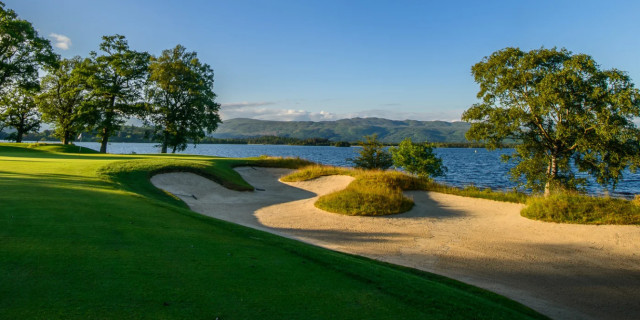
London Golf Club Heritage Course Review
The number of new golf courses springing up across the UK over the past decade or two has been limited. A mixture of limited demand and a turbulent economic landscape has meant, in many cases, it simply isn’t viable to construct, open and market a new golf club. That’s not to say no new clubs have opened up, though. The likes of Centurion Club and The Grove – one of the most highly-regarded five-star golfing resorts in Europe – have proved there is demand if the product is right, and the London Club – located in Kent – is another resort whose name must be mentioned alongside those two on the list of recent golf club success stories.
The London Club doesn’t just house two championship-standard golf courses, but also first-class off course amenities. The arresting clubhouse contains a sumptuous range of internal fittings and fixtures, which are perfectly complemented by a number of food and drink offerings. The practice facilities – including chipping greens, putting greens and a grass range bays – are kept in immaculate condition, a statement that applies to the venue as a whole.
There two layouts on the property are the Heritage and the International. I played the former, and whilst I didn’t rate it as highly as some, there can be no doubt it’s a very good golf course kept in the most fantastic condition.
It meanders beautifully over gently sloping terrain, with some excellent bunkering and water used intermittently to enhance the aesthetics of an already picturesque layout. A common criticism leveled at new, sprawling golf courses like the Heritage is the lack of character and charm, and I have to say it is somewhat devoid of personality. Still, the conditioning is impeccable, the course is beautifully presented and there is decent variation in holes.
Par 3s
For me, the par 3s are the stand-out feature of the golf course. They range from mid-irons to fairway woods and even drivers for some higher handicappers, and what I like is the variation and difference in protective features. The 11th, for example, features a front right to back-left sloping raised green with deep pot bunkers, which is indicative of the clever design throughout the set. As a general rule, water is used to guard some of the shorter holes, while a greater density of bunkers are employed on those longer layouts where holding the green with a long club is challenging.
After three relatively nondescript opening par 4s, the first short hole comes at the fourth. It plays slightly downhill to a green that’s perched between water on the left and a steep bank to the right. It’s a charming and secluded hole, and water is a real factor when the pin is placed front left. Playing safe is always the shrewd play here, but the long, narrow putting surface means three putts can be commonplace.
The next par 3 on the course comes at the 7th, and, in my view, it’s the best short hole on the course. It’s only a six or seven iron from the whites, but balls must carry at least 150 yards to clear an expansive lake that occupies the space between the tee and the green. Wooden slats supporting the raised green are visible from the tee, adding an extra dimension to the tee shot, and the steep slope through the green ensures a treacherous downhill chip for those who overcompensate by taking too much club from the tee.
Par 4s
The weakest component of the golf course is probably the set of par 4s, but that’s not to say there aren’t some striking, testing and varied holes among the selection. Bunkering is very impressive on this golf course, and that is most prominently displayed on the mid-range holes. What’s more, the natural undulations of the terrain and inventive use of water combine to create some stand-out holes. However, there are a few similar, largely forgettable holes, and in my opinion, the ability to make every hole different is what separates a good course from a great course.
In my view, two par 4s deserve an extended mention: the 10th and the 18th. There are some decent par 4s on the front nine, but they don’t linger as prominently in the memory as those with water. The 10th plays downhill from an elevated tee, which presents a lovely countryside panorama. There is thick rough right and a huge lake – which is shared with the final hole – to the left. If you find the relatively generous fairway, you’ll still face a long iron to a green that’s raised significantly above the level of the short grass. The 18th follows a similar pattern, with a downhill start followed by a steeply uphill second. The preferred shot shape is a draw skirting the edge of the lake, but only the longest hitters will be able to get home in two with an iron. The raised green is very tough to hit with a long club, and the three-tiered putting surface – which slopes from back to front – adds to the difficulty of the hole.
Par 5s
The par 5s are a really good set, and again, water, natural undulations and clever design combine to create a diverse selection of long holes, from reachable par 5s to water-fronted 500 yard-plus holes where par is almost akin to a birdie. In truth, all the long holes could be singled out for an extended mention, but I’d prefer to focus solely on the 541-yard 5th – one of the best par 5s in the UK.
Drives are hit from a relatively sheltered tee to a fairway guarded on the right by a cluster of bunkers. The hole isn’t particularly memorable for the first 250 yards, but that changes completely when you move over the brow of the hill. From that point, the hole swings dramatically down to the right, with some of the heaviest rough on the course waiting to the left. The prudent play is to lay-up, even if you’re a long hitter, because the water that flanks the right of the fairway cuts in front of the thin putting surface. It’s a visually stunning hole demanding strategy, course management and execution of shots in equal measure.
Overall, the Heritage Course at the London Club is well worth a visit. Granted, it lacks character and personality, and some of the holes (especially the par 4s on the front nine) are a touch monotonous, but it’s a beautiful layout maintained in superb condition with some excellent holes. Overall, I’d give the Heritage a rating of 8/10.
Review completed by Golfshake writer Nick Bonfield who played the Heritage Course November 2013
Related Articles
Related Content:





